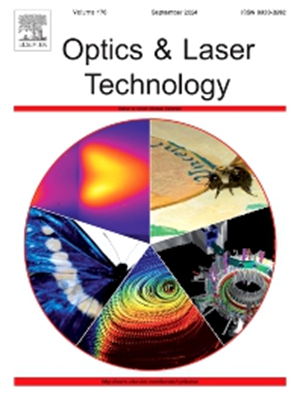Effect of CsPbBr3 quantum dots with different X-type ligands as additives on third-order nonlinear optical response in perovskite thin films
IF 4.6
2区 物理与天体物理
Q1 OPTICS
引用次数: 0
Abstract
This work investigates the characteristics and applications of nonlinear optical (NLO) parameters—including the nonlinear refractive index (n2), nonlinear absorption coefficient (β), and susceptibility—in triple-cation perovskite thin films with incorporated CsPbBr3 quantum dots (QDs) capped with two different ligands (DDAB and OAm&OA) at varying concentrations. Ligands, by altering the electronic environment and surface structure, can enhance the density of active electrons involved in light-matter interactions. The highest values of n2 and β were observed in PSK@QD(OAm&OA) at a concentration of 0.15 mg/ml, with values of 1.89 × 10−5 cm2/W and 4.24 × 10−1 cm/W, respectively. Incorporated QDs with different ligands at various concentrations significantly influenced the nonlinear absorption mechanism. Additionally, the impact of incorporated CsPbBr3 QDs with different X-type ligands on the transverse optical (TO) and longitudinal optical (LO) phonon modes was studied. The polarizability and distinct ring structures of the ligands also affected the NLO responses. These results indicate that these materials have significant potential for applications in optical communications, sensing, and various optoelectronic devices, as their nonlinear properties can be fine-tuned by modifying the QDs ligands and the QDs concentrations.
求助全文
约1分钟内获得全文
求助全文
来源期刊
CiteScore
8.50
自引率
10.00%
发文量
1060
审稿时长
3.4 months
期刊介绍:
Optics & Laser Technology aims to provide a vehicle for the publication of a broad range of high quality research and review papers in those fields of scientific and engineering research appertaining to the development and application of the technology of optics and lasers. Papers describing original work in these areas are submitted to rigorous refereeing prior to acceptance for publication.
The scope of Optics & Laser Technology encompasses, but is not restricted to, the following areas:
•development in all types of lasers
•developments in optoelectronic devices and photonics
•developments in new photonics and optical concepts
•developments in conventional optics, optical instruments and components
•techniques of optical metrology, including interferometry and optical fibre sensors
•LIDAR and other non-contact optical measurement techniques, including optical methods in heat and fluid flow
•applications of lasers to materials processing, optical NDT display (including holography) and optical communication
•research and development in the field of laser safety including studies of hazards resulting from the applications of lasers (laser safety, hazards of laser fume)
•developments in optical computing and optical information processing
•developments in new optical materials
•developments in new optical characterization methods and techniques
•developments in quantum optics
•developments in light assisted micro and nanofabrication methods and techniques
•developments in nanophotonics and biophotonics
•developments in imaging processing and systems

 求助内容:
求助内容: 应助结果提醒方式:
应助结果提醒方式:


